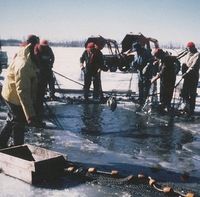How often do people survive an attack on the brain, you are the editor, how depth begins with 140 characters, embracing winter or at least faking it, the death of Maj. Winters.
The Monday Morning Rouser this week is designed to melt ice dams:
1) SURVIVING
This week, we’re all becoming more informed about what damages the brain in the wake of Saturday’s shooting of Rep. Gabrielle Giffords. What does it take to survive a bullet to the brain? LiveScience.com provides the answer:
A shooting victim stands a better chance if they don’t stop breathing and if their blood pressure remains high enough — both functions are needed to maintain an adequate oxygen supply to the brain. Arriving at a Level 1 trauma center — the highest level and most prepared to provide care for such injuries — shortly after such a trauma can help maintain or sometimes restore these functions
How often does it happen that someone can be shot in the head and survive? Not often, Slate says, but it happens. In Wisconsin over the weekend, for example, a sheriff’s deputy killed his girlfriend and several others, then shot himself in the head… three times. He survived.
NPR has apologized for mistakenly reporting that Rep. Giffords had died:
The information we reported came from two different governmental sources, including a source in the Pima County Sheriff’s Department. Nonetheless, in a situation so chaotic and changing so swiftly, we should have been more cautious. There were, obviously, conflicting reports from authorities and other sources. The error we made was unintentional, an error of judgment in a fast-breaking situation. It was corrected immediately. But we deeply regret the error.
The sources, it’s fair to say, were unreliable and uninformed. So why were they used? That’s the element NPR and other journalism experts haven’t addressed. Who were the sources? Should they have been granted anonymity? Why are they still deserving of that anonymity?
The AP’s David Bauder says Saturday’s media coverage unveiled another reality:
Now the reporting ranks have been thinned to the point that many news organizations are, in effect, relying on each other.
“Most news sites, whether they be on the Internet, television, radio or print, have been hollowed out to the point where they are news packagers and not news gatherers,” Rather said.
Meanwhile, the debate over whether political rhetoric is at the heart of the attack continues. The Sarah Palin “target map” has been one of the, err, targets of those who say it fueled the emotion that led to the attack. But the New York Times’ Paul Krugman says there should be little doubt about the words of Minnesota congresswoman Michele Bachmann.
Where’s that toxic rhetoric coming from? Let’s not make a false pretense of balance: it’s coming, overwhelmingly, from the right. It’s hard to imagine a Democratic member of Congress urging constituents to be “armed and dangerous” without being ostracized; but Representative Michele Bachmann, who did just that, is a rising star in the G.O.P.
That, blogger Mitch Berg suggests on his Shot in the Dark blog, ignores the gun-loading rhetoric of the left:
Now, the insane and the not-very-bright do tend to be drawn to one political extreme or another. To listen to the caterwauling of the left, the right – and only the right – needs to watch it’s rhetoric so that…
…so that the insane don’t get the wrong idea?
I’m still unclear on what it is they’re looking for, besides trying to slander and/or shut up the right.
Here’s something both sides can get behind: There’s a national moment of silence this morning at 10. It would be nice if it looked like this:
2) YOU ARE THE EDITOR
You are the editor of a big-city newspaper. The local NFL team is in the playoffs the same day a congresswoman is shot and 6 people are killed in a rampage that leaves the nation reeling. What’s your lead story?
Yesterday’s front page of the NY Daily News:
And the newspaper in Indianapolis:
And Seattle:
3) DEPTH BEGINS WITH 140 CHARACTERS
Twitter and texting have been getting a bum rap, Wired’s Clive Thompson argues today. Far from reducing the human mind’s capacity for deep thinking, it nurtures it, he says:
When something newsworthy happens today–Brett Favre losing to the Jets, news of a new iPhone, a Brazilian election runoff–you get a sudden blizzard of status updates. These are just short takes, and they’re often half-baked or gossipy and may not even be entirely true. But that’s OK; they’re not intended to be carefully constructed. Society is just chewing over what happened, forming a quick impression of What It All Means.
The long take is the opposite: It’s a deeply considered report and analysis, and it often takes weeks, months, or years to produce. It used to be that only traditional media, like magazines or documentaries or books, delivered the long take. But now, some of the most in-depth stuff I read comes from academics or businesspeople penning big blog essays, Dexter fans writing 5,000-word exegeses of the show, and nonprofits like the Pew Charitable Trusts producing exhaustively researched reports on American life.
4) EMBRACING WINTER
 By January, local weatherpeople should be over making a big deal out of the possibility that an inch of snow will fall in the Twin Cities today? An inch? Today’s “The Story” from American Public Media isn’t for them; it’s for real Minnesotans and the ones who at least try to fake it by pretending they’re real Minnesotans. Dick Gordon profiles Curt Piechowski, a northern Minnesota man who fishes with nets on the frozen lakes of flyover country.
By January, local weatherpeople should be over making a big deal out of the possibility that an inch of snow will fall in the Twin Cities today? An inch? Today’s “The Story” from American Public Media isn’t for them; it’s for real Minnesotans and the ones who at least try to fake it by pretending they’re real Minnesotans. Dick Gordon profiles Curt Piechowski, a northern Minnesota man who fishes with nets on the frozen lakes of flyover country.
He follows that up with a marvelous soundscape of the John Beargrease sleddog race, which begins in Duluth at the end of the month.
Who are the unsung heroes for those who aren’t afraid of winter? The people who maintain outdoor ice rinks, for one.
5) THE DEATH OF A ‘GREATEST’
Dick Winters has died. He was the man who commanded the “Band of Brothers,” made more famous in the book by Stephen Ambrose:
Who didn’t tear up at the conclusion of the HBO series when the “real person” added the final words?
TODAY’S QUESTION
The shootings of a congresswoman, a judge and 18 others in Arizona on Saturday are a graphic reminder of the dangers of public service. What can we do to make our public officials safer?
WHAT WE’RE DOING
This lineup is likely to change in the wake of Saturday’s shootings. But as of 7 a.m., here is what’s planned for today:
Midmorning (9-11 a.m.) – First hour: Gov. Mark Dayton says his proposed budget solution will be reasonable, balanced, and painful for Minnesota. Leaders of the House Taxes Committee discuss how that budget proposal will affect Minnesota’s taxpayers.
Second hour: The key to longevity.
Midday (11 a.m. – 1 p.m.) – First hour: New Education Commissioner Brenda Cassellius is in the MPR studios to answer questions from listeners about the future of education in Minnesota.
Second hour: A Youth Radio special
Talk of the Nation (1-3 p.m.) – First hour: What should Obama do?
Second hour: Karen Armstrong, author of “Twelve Steps to a Compassionate Life.”
All Things Considered (3-6:30 p.m.) – We’ve all seen pictures of hunger – African babies with bloated bellies or malnourished teens in 1960s Mississippi. But that’s not what hunger looks like in Minnesota in 2011. Often, it’s someone who depends on food shelves or food stamps, but still must make sacrifices to feed their family. MPR’s Julie Siple will have the story.



